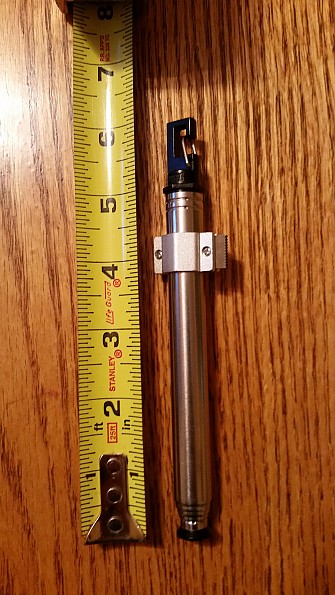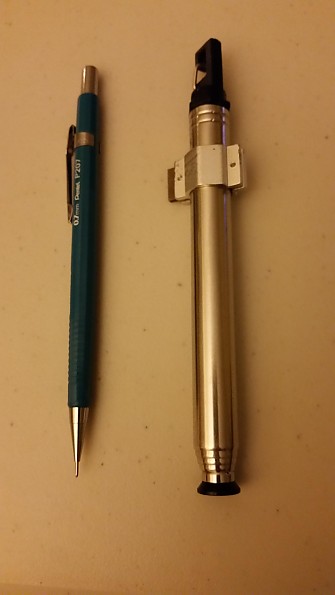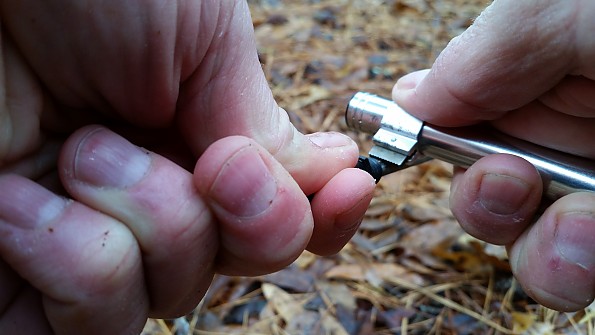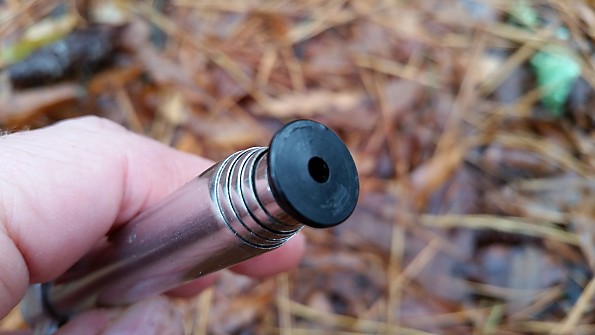Vargo Ultimate Fire Starter

The Vargo Ultimate Fire Starter is a good idea and handy gadget that functions as a spark lighter with ferrocerium (ferro) rod and bellows. I would recommend it to folks who like wood stoves and building fires, but there are better options if all you need is a spark lighter to light a stove, as the dual function and convenience result in a couple of areas that could improve.
Pros
- Dual function—spark lighter and bellows
- Convenient clip allows for safe and easy storage
- Bellows are handy to start/adjust a fire even soaked wood
- Strike lighter works in all conditions (water and wind proof)
- Quality construction
- Replaceable ferro rod and clip handle
Cons
- Serrated striker slightly outperformed by back of blade or striker
- Ferro rod could be a bit longer to produce more spark
- Carrying clip sacrifices comfort on handle
 Vargo subtitles this device with “Just add fuel”, and that is fitting. The Ultimate Fire Starter (hereafter called UFS for convenience) is a neat product that provides a spark light off a ferro rod in wind and rain, while nesting in an extendable bellows. I considered the bellows function a luxury on first use, but now would really miss it for starting or adjusting wood stoves and fires.
Vargo subtitles this device with “Just add fuel”, and that is fitting. The Ultimate Fire Starter (hereafter called UFS for convenience) is a neat product that provides a spark light off a ferro rod in wind and rain, while nesting in an extendable bellows. I considered the bellows function a luxury on first use, but now would really miss it for starting or adjusting wood stoves and fires.  The UFS comes in a pleasingly simple package—a small plastic bag (now being used to hold some odds and ends in my equipment box) and a recyclable cardboard backing. Instructions were limited and basic on the back, but the website has a handy video for those not used to spark lighters and for the bellows.
The UFS comes in a pleasingly simple package—a small plastic bag (now being used to hold some odds and ends in my equipment box) and a recyclable cardboard backing. Instructions were limited and basic on the back, but the website has a handy video for those not used to spark lighters and for the bellows.
The ferro rod is held in the handle (with clip) that screws into the top end of the extendable bellows, which are capped with a ferrule with a small opening. The striker is securely held onto the top of the bellows with a screw clamped holder.
Construction
I was a little surprised when I received the UFS that Vargo produced this without titanium, for which they are known, but obviously quality construction was the driver for this design and titanium would not be appropriate for the intended function.
Before discussing construction in detail, I thought it would help to have the parts labeled for clarity in the photo below. I may occasionally call the striker a scraper or spark lighter (in combination with the ferro rod) during the review. Vargo mentions “sturdy stainless steel construction” on their website, but some parts seemed to be slightly different materials; so I inquired through Trailspace for more detail.
Vargo mentions “sturdy stainless steel construction” on their website, but some parts seemed to be slightly different materials; so I inquired through Trailspace for more detail.
Here is a breakdown:
- 420 high carbon steel striker
- Stainless steel bellows
- Aluminum ferrule (end of bellows shaft)
- Aluminum striker holder
- Plastic clip handle
 Vargo lists the length when compact and with bellows extended.
Vargo lists the length when compact and with bellows extended.
My measurements were very similar:
- Compacted length: 6 inches (5.9 listed)
- Bellows extended (without clip): 18.25 inches (18.2 listed)
- Ferro Rod (not including clip/handle): 1.75 inches (not listed)
 The website lists the weight as 1.8 ounces (53 grams), and on my home scale I got a slightly higher 2 ounces (56 grams)—the difference in ounces is mostly due to rounding (I rounded up and Vargo rounded down) – let’s call it 1.9 ounces as a compromise!
The website lists the weight as 1.8 ounces (53 grams), and on my home scale I got a slightly higher 2 ounces (56 grams)—the difference in ounces is mostly due to rounding (I rounded up and Vargo rounded down) – let’s call it 1.9 ounces as a compromise!
Convenience and “Packability”
 As a thin “pencil” like shape with a handy carrying clip, the UFS was able to be slipped into a pocket of my shirt, down the center of my Caldera Ti Tri packed roll, or into a side pocket of my pack. The latter ended up being my preferred carry method as it was securely clipped to a compression cord and within easy reach throughout the day.
As a thin “pencil” like shape with a handy carrying clip, the UFS was able to be slipped into a pocket of my shirt, down the center of my Caldera Ti Tri packed roll, or into a side pocket of my pack. The latter ended up being my preferred carry method as it was securely clipped to a compression cord and within easy reach throughout the day. You can see the UFS in the outside pocket of my ULA Ohm on the far right. I never worried about losing it as the clip seems very sturdy.
You can see the UFS in the outside pocket of my ULA Ohm on the far right. I never worried about losing it as the clip seems very sturdy.
Testing Methods
When I volunteered to test the UFS for the Review Corps, I had no idea what the upcoming months would be like! I am not sure I could have encountered worse conditions for testing a fire starter: months of drought, record wildfires in the Southeast, and burn bans in most areas. As they say, when life hands you a lemon, make some lemonade…
I wanted to thoroughly test the fire starter in as many conditions so used a combination of backyard laboratory and backcountry real-world experience. I also used it in several fire ban areas after checking with rangers that my Caldera Ti Tri wood/alcohol/esbit stove’s wood burning option was legal.
There was one instance where it was questioned as wood stoves were not specifically addressed in that area's ban, until we got into a discussion of the reason for my request. The representative ended up being a fan of Trailspace reviews, and decided to allow it with a promise of my strict supervision.
I used the Ultimate Fire Starter for several different functions:
- Lighting the Caldera Ti Tri 12-10 alcohol stove
- Lighting the Caldera Ti Tri wood burning option with commercial and natural tinder
- Re-stoking the wood burning stove during cooking or after dinner
- “Lab” testing in the backyard fire pit
In order to compare the UFS to other similar equipment, I used both my standard/traditional fire lighting techniques and more controlled comparisons using commercial fire starters. Tinder used for fire starting included:
- Coghlan's Fire Paste
- Coghlan's Waterproof Fire Sticks
- Light My Fire Tinder-on-a-Rope (Fatwood)
- Natural kindling (leaves, grass, twigs, etc as appropriate and available)
- UST Wetfire Tablets
- Zippo Waxed Tinder Sticks (without their Emergency Fire Starter Kit)
The testing occurred from October through December 2016, along with an additional "lab" test in January. Field testing included four backpacking trips of 2-4 nights, and over 20 backyard fire pit tests. Weather ranged from mid-80s down to 10 degrees and windy. No rain occurred during my backcountry trips, but I used the UFS several times during mist, light rain, and steady rain in December in the back fire pit.
On an average backpacking trip, I usually sacrifice mileage for relaxation and often take multiple breaks at scenic points. On bad weather days, I stop less often but spend more time in camp cooking multiple meals and hot drinks. Typical daily use in the backcountry included:
- 2-3 spark lights of the 12-10 alcohol stove (some breakfasts, late morning trail coffee on cold hikes, lunch or afternoon tea almost every day, and early camp soup on many days)
- 2-4 wood stove fires (most breakfasts, lunches on cold days, all dinners, and many times a post-dinner restart for hot cider or just for fun and testing purposes)
If I had to guesstimate, I would say that the UFS has been used over 30 times each as a pure spark lighter (alcohol stove) and a wood stove fire starter, in addition to 20+ fires and numerous tests in the back yard fire pit, for a total of over 80 tests.
Results
Since the UFS has dual purposes as a spark lighter and bellows, I will address each function separately.
Function 1: Spark Lighter
One thing that is not noted on many brands of spark lighter, including the UFS, is that it functions much better once the initial coating on the ferro rod is scraped off. The discussion below assumes this has been performed. I have used several spark lighters for over 10 years (my memory doesn’t go back much further) but with increased frequency the last five years since switching primarily to alcohol and wood burning stoves. Therefore, I had a preconceived notion of how the UFS would function.
My first impression was that the overall function of the spark lighter (striker and ferro rod) was slightly worse than my standard (a Light My Fire Swedish Fire Steel) but better than a recent addition (Light My Fire Swedish Fire Knife). I think this is primarily due to the fact that the length of the ferro rods corresponded to my rating by providing a longer or shorter run to generate the sparks.
There was a little learning curve to the use of the UFS spark lighter. I first angled the striker about 90 degrees (perpendicular) to the ferro rod as that is what I thought I saw in the video on the Vargo website. However this wasn’t very good at producing sparks and didn’t seem that natural of a motion.
I then tried multiple variations and settled on about a 30-45 degree angle with the striker both oriented away from and toward the end of the ferro rod. While both these worked well enough, I feel that it functions best when the striker is oriented away from the end of the ferro rod, or toward your body (see below).  This may be due to the angle reducing the amount of serration/grooves exposed along the ferro rod during a strike (see below). Usage got easier with practice, as do most things, and learning where to balance it with your thumb on the striker holder makes it a much smoother action.
This may be due to the angle reducing the amount of serration/grooves exposed along the ferro rod during a strike (see below). Usage got easier with practice, as do most things, and learning where to balance it with your thumb on the striker holder makes it a much smoother action.
This is me still in the learning stage, but it shows how easy it is to light an alcohol stove with the UFS. The scraper or striker is made of steel with a slightly serrated end. While I think the serration grooves are intended to increase the amount of sparks generated, I found this to be the opposite in practice.
I couldn’t figure out a good way to measure the amount of spark produced, so you will have to work with my description and this video from the backyard “lab” that compares the UFS to a couple other options. Note that since I filmed in the dark so its easier to see the sparks generated, I did miss a couple of strikes since I couldn’t see well…that was user error not the result of the spark lighter.
The striker worked decently, but by comparison using the striker from my fire steel or the back of my knife on the UFS ferro rod generated even more sparks based on unscientific observation that hopefully can be seen in the video. I feel like the flat edges have more contact with the ferro rod, therefore increasing the amount of spark. This by no means suggests that the built in striker doesn’t work—it functions as designed and will light an alcohol stove and a wood fire with good tinder in both wind and rain.
While using the spark lighting function, comfort should be considered. This is a minor issue if you are lighting an alcohol stove, and only slightly more important if you are lighting a fire in good conditions or with excellent tinder or other fire starting material. If you have adverse conditions, or sub-par tinder, the spark light process may take longer and comfort is important, especially with cold fingers.  The handle of the UFS ferro rod is also the handy clip that keeps it secure. This multi-function definitely sacrifices a bit of comfort, as I much prefer the smooth plastic of the Light My Fire fire steel to holding the end of the carrying clip for more than a few strikes.
The handle of the UFS ferro rod is also the handy clip that keeps it secure. This multi-function definitely sacrifices a bit of comfort, as I much prefer the smooth plastic of the Light My Fire fire steel to holding the end of the carrying clip for more than a few strikes.
The efficiency of lighting and heat of the sparks were tested only by comparison. Using easy chemical or other manufactured tinder, such as Coghlan's Fire Paste, UST Wetfire, and Zippo Tinder Sticks, the UFS was able to produce a flame within a strike or two of my previous go-to option (Swedish Fire Steel). It was an equal to the fire steel using the back of my knife instead of the striker.
Function 2: Bellows
As I mentioned above, I first considered the bellows function a luxury but before my first backpacking trip with the UFS was done I realized I would really miss having one around. For starting up a finicky wood stove or fire, the bellows works really well. It also works great stoking the fire to dry out wet wood.
The following video was shot after two straight days of rain (about 1.5 inches) and extremely soaked wood and kindling that I purposely did not dry out during another upcoming review of a manufactured tinder stick.
The extension to 18 inches allows you to blow on the fire without bending over too far or getting your face too close to the heat and flame, and reduces the potential for a face full of smoke. It allows you to direct the air flow to exactly the portion of the fire that you need. Another benefit is the extendable bellows necks down four times at each nesting section before ending in a small ferrule opening. This increases the velocity of the air flow without working too hard.  I found it very easy to use multiple times in a row to stoke a troublesome little fire without getting lightheaded or out of breath…the light headedness usually comes from almost bending upside down to get near the fire the old fashioned way.
I found it very easy to use multiple times in a row to stoke a troublesome little fire without getting lightheaded or out of breath…the light headedness usually comes from almost bending upside down to get near the fire the old fashioned way.
In addition to starting the wood stove/fire, it was also very nice to just casually lean over and restart the coals with a few breaths if the fire went out after dinner was cooked. I must have done this almost every night to enjoy a brief fire in the Caldera Cone on cold nights or to get things going again for hot cider or other after dinner treats.
For a wood stove, where you don’t have the flexibility of adjusting the pot away from the heat as easily as a fire, I usually like to cook over a very low flame or preferably coals. Sometimes it is nice to “crank” it back up, and the UFS bellows is an easy way to do this. I found myself constantly adjusting the wood stove from “low” to “medium” to “high” (the latter after dinner to boil up water for cleaning).
One note on adjustments during cooking—make sure your pot lid is on unless you want some ash in your dinner!
As far as the mechanical aspects of the bellows, it seems to function well. Extending and closing the bellows is a little stiff, but I found it just tight enough a fit that no dirt or debris has made it in between the nesting segments to jam things up. Time will tell if that may happen but I am not worried at this point. Some mornings there was dampness on the segments but it didn’t affect the function and no rusting has occurred thanks to the primarily stainless steel construction.
Durability
The UFS seems to be well thought out and constructed, and so far I have noticed no issues with wear and tear or failure of the device. I was initially concerned about the obviously plastic construction of the clip handle and also if the extendable nesting sections would bend and not fit back together well.
I have carried the UFS in my back pocket around camp (and sat on it many times), as well as outside my pack shoved down with other items, and no bending or weakness can be seen. The extended bellows does have some flex to it, but returns to its shape immediately.  It’s stiff as mentioned but relatively easy to collapse. I don’t leave it lying around extended so haven’t managed to step on it yet! The plastic handle is heavy duty and has not failed or showed weakness even though it is the point of contact when holding the ferro rod. The aluminum ferrule end of the bellows seems durable as well. Even after getting it too close to the fire it has not warped or melted. The striker holder is a little dinged up after three months of regular use, but fully functional.
It’s stiff as mentioned but relatively easy to collapse. I don’t leave it lying around extended so haven’t managed to step on it yet! The plastic handle is heavy duty and has not failed or showed weakness even though it is the point of contact when holding the ferro rod. The aluminum ferrule end of the bellows seems durable as well. Even after getting it too close to the fire it has not warped or melted. The striker holder is a little dinged up after three months of regular use, but fully functional.
 The ferro rod is worn down as you would expect due to all the testing use (much more than normal use) but is not weaker and I suspect has hundreds of uses left. Vargo offers replacement parts for the UFS so the ferro wear, which is similar to others I own, is not going to limit the life of the product. The ferro rod is smaller than some others, but that reduces weight slightly so is a compromise I am willing to take.
The ferro rod is worn down as you would expect due to all the testing use (much more than normal use) but is not weaker and I suspect has hundreds of uses left. Vargo offers replacement parts for the UFS so the ferro wear, which is similar to others I own, is not going to limit the life of the product. The ferro rod is smaller than some others, but that reduces weight slightly so is a compromise I am willing to take. Conclusion/Recommendation
Conclusion/Recommendation
The Vargo Ultimate Fire Starter is a nice little dual function device. I gave it 4 stars as it provides both functions well, but probably would have given the spark light function 3.5 stars on its own. The UFS could be improved with a more comfortable handle and a non-serrated striker edge, but a comfortable handle could sacrifice the carrying clip that makes it so handy to have around.
If allowed to keep this test product, I would definitely continue to carry it due to my frequent use of the wood stove option of my Caldera Ti Tri. I might toy with removing the striker and just use the back of my knife.
I would not recommend this for alcohol stove lighting only, as single function spark lighters would better serve that purpose. There are slightly more efficient spark lighters available if you practice a lot of bush craft or make a purchase decision based on absolute worst-case conditions, but I feel the bellows feature can offset this and makes the UFS a practical option.
Thanks to Trailspace and Vargo for providing this opportunity to test the Vargo Ultimate Fire Starter.
Source: received for testing via the Trailspace Review Corps
(Sample provided by Vargo for testing and review)
Your Review
Where to Buy
You May Like
Specs
| Price |
MSRP: $24.95 Current Retail: $24.95-$29.95 Historic Range: $24.95-$39.99 |
| Weight |
1.8 oz / 53 g |
| Length extended |
18.2 in / 464 mm) |
| Length collapsed |
5.9 in / 152 mm |


